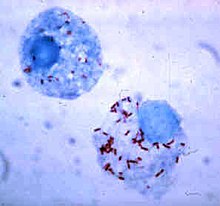Rocky Mountain spotted fever
| Classification according to ICD-10 | |
|---|---|
| A77.0 | Tick bite fever caused by Rickettsia rickettsii - Rocky Mountain fever - São Paulo fever |
| ICD-10 online (WHO version 2019) | |
The Rocky Mountain Spotted Fever ( Engl. Rocky Mountain spotted fever ) is the most common and running hardest by rickettsial disease caused in the United States . It occurs all over the American continent . In other countries it is referred to as tick typhus or Tobia fever ( Colombia ), São Paulo fever or febre maculosa ( Brazil ) or fiebre manchada ( Mexico ). Without prompt and targeted treatment, the Rocky Mountains spotted fever can be fatal.
Pathogen

The causative bacterium is Rickettsia rickettsii , an obligate intracellular parasite. It is transmitted by shield ticks of the genera Amblyomma and Dermacentor . In nature, rickettsiae perform a complex host change between arthropods and mammals ; man is basically a false host.
Epidemiology and spread
The cases have been registered in the USA since 1918. Between 250 and 1200 cases of illness have been reported annually over the past 50 years. It is very likely that the actual number of cases is significantly higher. More than 90% of patients become infected between April and August. In the majority of cases, a previous tick bite can be determined.
The name Rocky Mountain spotted fever is actually inappropriate, since it became apparent since the 1930s that areas far outside the Rocky Mountains were also affected. Today the continental part of the USA, southern Canada , Mexico and large parts of South America are included in the distribution. In the United States, the states of North Carolina and Oklahoma are hardest hit. In the states around the Rocky Mountains, only around 3% of the total cases are recorded.
Symptoms
The incubation period varies between three and twelve days and averages seven days. The shorter the incubation period, the more severe the disease. The first symptoms are suddenly rising fever , headache , nausea with vomiting , muscle pain and a rash. Diarrhea and abdominal pain can also occur. In the early stages, the disease is difficult to diagnose because the rash does not become apparent until about six days after the first symptoms. This initially consists of small, not raised, purple, non-itchy spots ( macules ) on the wrists, ankles and forearms. Later these lesions will be slightly raised. The typical red and blotchy rash that gives it its name can only be observed in about every second patient. Pathophysiologically, it is petechiae , i.e. widely scattered bleeding into the skin.
Complications can arise from manifestations in the lungs , kidneys , gastrointestinal tract, and central nervous system .
diagnosis
In addition to the clinical picture, laboratory findings such as thrombocytopenia , hyponatremia and elevation of liver enzymes can sometimes help.
therapy
Treatment must be started immediately if it is suspected. Effective antibiotics are doxycycline and chloramphenicol , the latter should only be considered as reserve medication because of possible serious side effects. Treatment is continued for at least three days beyond the defever.
forecast
Rocky Mountain spotted fever remains a dangerous and potentially life-threatening disease today. Despite the availability of effective antidotes, 3–5% of those affected still die. However, effective antibiotic therapy has significantly reduced mortality . Almost every third infected person died before they were used.
history
The first description comes from the year 1896. The disease occurred at that time in the Snake River Valley ( Idaho ) and was called "black measles" because of the characteristic skin conditions. The dreaded and often fatal disease affected hundreds of people in the region. At the beginning of the 20th century it expanded to areas between Washington and Montana in the north and California and Arizona in the south.
Howard Taylor Ricketts first identified the infectious organism that caused the disease. Together with other scientists, he succeeded in determining the basic epidemiological facts and understanding the role of ticks as a vector. Dr. Ricketts died tragically shortly after the publication of his studies in 1910 at another caused by Rickettsia disease, typhus (eng. Typhoid ).
Individual evidence
- ↑ a b c Rocky Mountain spotted fever - infectious diseases. Accessed June 11, 2019 (German).
